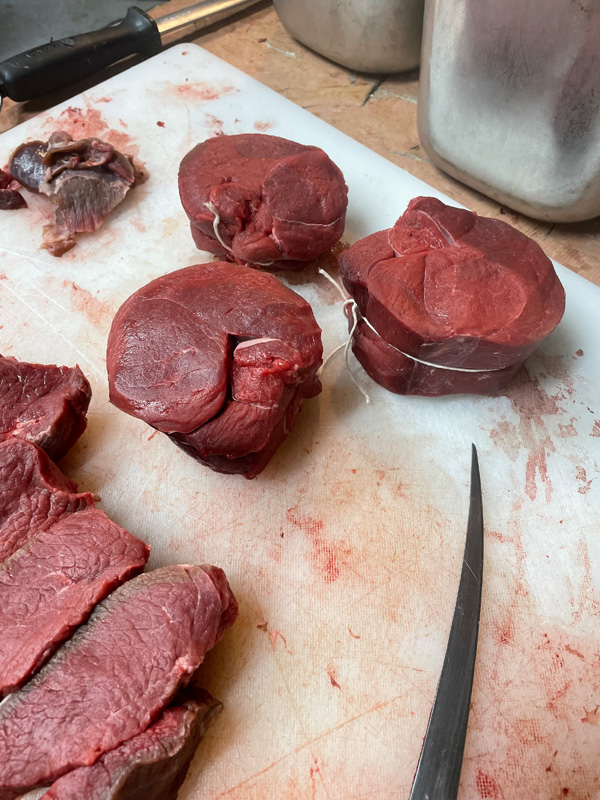Biologists estimate that the deer population on Martha’s Vineyard has recently grown as high as 50 deer per square mile, with the whole Island estimated at around 100 square miles in total — that’s a whole lot of meat.
Not only is venison healthy and delicious, but eating venison harvested from deer on Martha’s Vineyard puts the consumer just about as close to the source as possible. Brian Athearn, avid hunter and president of the Martha’s Vineyard Agricultural Society, told Edible Vineyard he got into hunting when he was young and just returning from the military. He started out with black powder hunting, but soon found his passion in shotgun hunting, and bowhunting eventually became his favorite way to take deer.
“Next thing you know, I’m looking around for a place to hang our deer,” Athearn said. “Chris Pantalone from down at Rocco’s [Pizzeria] was selling a walk-in cooler.” After a bit of back-and-forth, Athearn got a great deal on the cooler, and began setting it up down at his farm. Having a large enough storage space for the meat, Athearn said, is key to being able to age and preserve the tasty and protein-packed venison.
“When you have a walk-in cooler, you all of a sudden have a lot of friends,” Athearn laughed. “We all started getting together to hang and butcher deer, and that’s how the [M.V.] Hunt Club formed.” Athearn’s hunt club encourages new hunters, and provides them with a vast pool of decades of combined experience, along with knowledge on how to properly skin, quarter, and butcher a deer.
“Pulling the trigger on a deer is the easiest part, by far. From soup to nuts, it’s a whole lot of work to even get a deer. Finally you kill one, and now you have to deal with the deer, and process the meat the right way,” Athearn said. He soon learned unique and efficient techniques for processing whole deer, and then started getting into the various ways to prepare delicious meals out of venison.
For Athearn, venison is a staple of his family’s diet, and he said there are many different ways to serve the rich, dark red meat. At the M.V. Hunt Club, members work on preserving, aging, and cooking venison via a variety of methods. “I eat venison probably five times a week or more,” Athearn said.



According to Athearn, it takes hours to butcher a deer properly. With some finessing and experience, skinning and quartering a deer takes about 15 or 20 minutes. Skinning helps cool down the meat so it doesn’t spoil, and quartering involves separating the forequarters, hindquarters, and backstraps from the carcass. Having the right equipment helps, Athearn said, but even with the most efficient and refined techniques, getting venison ready for aging or storage is highly involved.
Apart from getting the deer processed, the aging process is also essential in producing a steak that is not only delicious, but has a pleasant and buttery consistency. The Hunt Club folks like to age their deer for at least two or three weeks in a climate-controlled environment. Sometimes they age deer up to five weeks, which creates a tender consistency and allows the enzymes in the muscle to break down and eliminate that gamy taste that some report when eating venison.
“When people say deer meat is gamy, it’s because you butchered the deer and ate it the very next day,” Athearn said. “If you butchered a cow and ate it the very next day, it would be gamy too.” He stressed the importance of aging deer, and related it to aging cask-strength whiskey. “You lose a lot of weight from evaporation, but what you get out at the end is so much better. Actually, it’s amazing,” Athearn said.
As far as cooking venison, Athearn said the key is to make sure all the meat cooks evenly. “You really don’t want to overcook venison. Everyone is always skeptical about undercooked meat, but if you cook it too much, you are dead in the water,” he said. Because venison is such a lean meat, especially when cooking a venison steak, you want to score the meat so that the heat can get inside the cut when using a pan or grill. “That way, it can cook faster on the inside, so you don’t end up with an overdone outside and an underdone inside,” Athearn explained.

Athearn often cubes his venison steaks so they cook more evenly, with more surface area exposed to the heat. This essentially achieves a similar goal to scoring five or six thick lines on either side of the steak. “You aren’t cubing it at that point, but allowing all the heat to really get in there,” he said.
For a succulent and flavorful meal, Athearn suggested scoring the steak, dredging in egg wash, and rolling in panko breadcrumbs. For those who like their steaks simple, a hot pan sear with a half-and-half mix of butter and olive oil is a great option. For the final touch, Athearn makes a beach plum reduction and drizzles it over the top of the steak. “That really brings out the natural flavor of the venison,” he said.
Of course, cooking up a tender steak isn’t the only way to enjoy venison. Grinding the venison into burger is also very popular on-Island, and at that point, the only limit to what meal you whip up is your creativity and how hungry you are. “Chili and burgers are definitely de facto. We will do Taco Tuesdays, and you really can’t beat a venison taco,” Athearn said. He also recommends sloppy joes and venison stir-fries as solid options for preparation. “When you shoot a smaller deer, we’ve even done a whole one of those on the smoker,” he said.
One special way venison is becoming more prominent in the mainstream diet of Islanders is through the venison donation program, managed by Island Grown Initiative and the Ag Society. The donation program allows hunters to donate their kills so the meat is processed properly. Then all that fresh meat is sent out to organizations like the Island Food Pantry and the Wampanoag Tribe of Gay Head, to support the local elderly population, along with anyone who is hungry or in need. “It’s pretty amazing, having a legitimate way to put wild game meat back into the diet of our community,” Athearn said.

